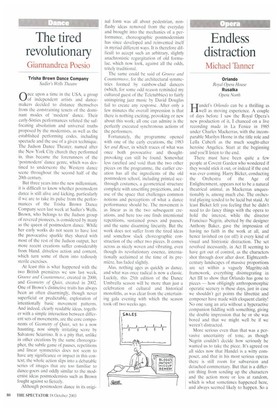The tired revolutionary
Giannandrea Poesio
Trisha Brown Dance Company Sadler's Wells Theatre
Once upon a time in the USA, a group of independent artists and dancemakers decided to distance themselves from the constraining tenets of the dominant modes of 'modern' dance. Their early-Sixties performances refuted the suffocating absolutism and universal truths proposed by the modernists, as well as the established performing codes, including spectacle and the use of a given technique. The Judson Dance Theater, named after the New York City church they performed in, thus became the forerunners of the 'postmodern dance genre, which was destined to underscore the Western dance scene throughout the second half of the 20th century.
But three years into the new millennium, it is difficult to know whether postmodern dance is still alive and kicking, particularly if we are to take its pulse from the performances of the Trisha Brown Dance Company seen last week at Sadler's Wells. Brown, who belongs to the Judson group of revered pioneers, is considered by many as the queen of postmodern dance. While her early works do not seem to have lost the provocative sparkle they shared with most of the rest of the Judson output, her more recent creations suffer considerably from bland. driveless action and content, which turn some of them into tediously sterile exercises.
At least this is what happened with the two British premieres we saw last week, Groove and Countermove, created in 2000, and Geometry' of Quiet, created in 2002. One of Brown's distinctive traits has always been an often disarmingly, though never superficial or predictable, exploration of intentionally basic movement patterns. And indeed, clearly readable ideas, together with a simple interaction between different sets of movements, are the core components of Geometry of Quiet, set to a now haunting, now simply irritating score by Salvatore Sciarrino. It is a pity that, unlike in other creations by the same choreographer, the subtle game of pauses, repetitions and linear symmetries does not seem to have any significance or impact in this context; the whole action slips into a debatable series of images that are too familiar to dance-goers and oddly similar to the modernist ideas postmodernists such as Brown fought against so fiercely.
Although postmodern dance in its origi
nal form was all about pedestrian, nonflashy ideas removed from the everyday and brought into the mechanics of a performance, choreographic postmodernism has since developed and reinvented itself in myriad different ways. It is therefore difficult to accept such an arbitrary, slightly anachronistic regurgitation of old formulae, which now look, against all the odds, tritely traditional.
The same could be said of Groove and Countermove, for the architectural symmetries formed by rainbow-clad dancers (which, for some odd reason reminded my cultured guest of the Teletubbies) to fairly uninspiring jazz music by David Douglas fail to create any response. After only a few minutes the overall impression is that there is nothing exciting, provoking or new about this work; all one can admire is the perfectly executed synchronous actions of the performers.
Fortunately, the programme opened with one of the early creations, the 1983 Set and Reset, in which traces of what was once both provocative and thoughtprovoking can still be found. Somewhat less rarefied and void than the two other pieces on the programme, the earlier creation has all the ingredients of the old postmodern school, including printed seethrough costumes, a geometrical structure complete with unsettling projections, and a use of the space that challenges common notions and perceptions of what a dance performance should be. The movement is as linear as in the two subsequent creations, and here too one finds intentional repetitions, sustained poses and pauses, and the same disarming linearity. But the work does not suffer from the tired ideas and somehow slack choreographic construction of the other two pieces. It comes across as nicely woven and vibrating, even though its revolutionary essence, internationally acclaimed at the time of its premiere, has faded slightly.
Alas, nothing ages as quickly as dance, and what was once radical is now a classic. Luckily, this 25th edition of the Dance Umbrella season will be more than just a celebration of cultural and historical monoliths, as was clear from the entertaining gala evening with which the season took off two weeks ago.


































































































 Previous page
Previous page